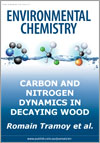EN16070Heteroagglomeration of nanosilver with colloidal SiO2 and clay
Environmental context. The fate of nanomaterials in the environment is related to their colloidal stability. Although numerous studies have examined their homoagglomeration, their low concentration and the presence of high concentrations of natural particles implies that heteroagglomeration rather than homoagglomeration is likely to occur under natural conditions. In this paper, two state-of-the art analytical techniques were used to identify the conditions under which nanosilver was most likely to form heteroagglomerates in natural waters.
EN16070 Abstract | EN16070 Full Text | EN16070PDF (912 KB) | EN16070Supplementary Material (2.9 MB) Open Access Article




